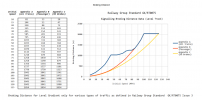GC class B1
Member
Moderator note: Split from https://www.railforums.co.uk/thread...ar-salisbury-fisherton-tunnel-31-10-21.224217
I am not a signalling specialist but my understanding is that four aspect signalling is more a requirement because of the higher line speed and therefore longer stopping distances.In a way it does though - otherwise we'd just have red and green. Of course that's the actual reason but in reference to the comment it has a side effect of increasing separation because the driver won't be going at line speed the whole time under cautionary aspects.
Last edited by a moderator:

